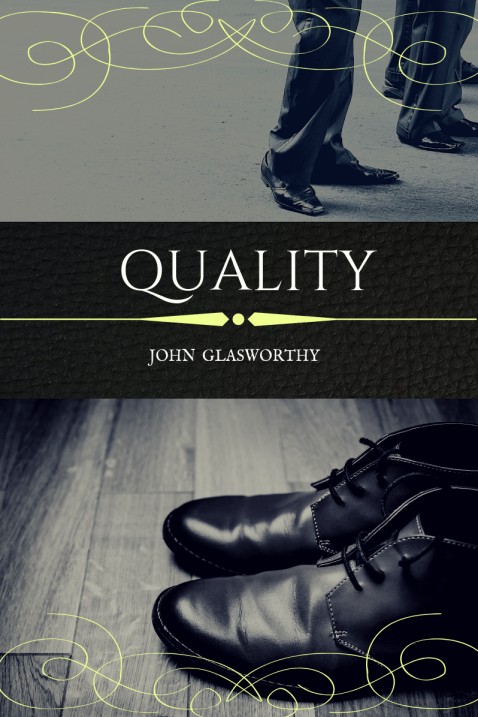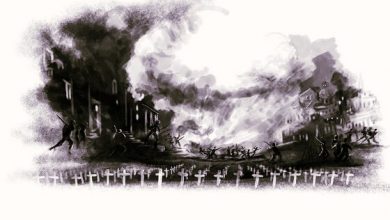
Quality : The story
Written in first person point of view, Quality is a touching account of a passionate shoemaker whose love and dedication towards his work is ruthlessly trampled under the juggernaut of Big Money. It is an account of how artists inevitably are the product of socio-economic conditions of the age they live in and the effect of what a purely materialistic approach towards craftmanship does to the artist and his art. This story by Glasworthy finds a deeper resonance in today’s age where “big firms” dominate the landscape and where there’s a tendency to judge Art through ‘virality’ instead of its virtue. Quality is an apt title for the story which describes the shift of the world towards one where it is conspicuous through its absence.
Got No Time? Check out this Quick Revision by Litbug by clicking the link below
https://m.facebook.com/Litbug.co/photos/a.353106305495706/888336738639324/?type=3&source=48
Quality : Summary
The story unfolds with the narrator describing his family’s relationship with the Gessler Brothers as their long-term customers and of how the Gessler Brothers used to make boots for his father. As the story progresses, the narrator familiarizes the reader with the ways of the Gessler Brothers and this sense of familiarity is crucial in understanding the story.
We are told that the Gessler Brothers were all substance and no show in a world that was working on a reverse logic. They used no signs to boast about having the “Royal Family” as their clientele nor did they use any other mode of advertisement. Every shoe they made spoke for itself and they didn’t require any name-dropping. The narrator goes on to state that they seemed to know the very essence of boot that they could craft into their physical form:
For it was not possible to go to him very often- his boots lasted terribly, having something beyond the temporary – some, as it were, essence of boot stiches into them.
This is perhaps a good entry point to closely look at the Gessler Brothers and the ethos they stand by. Mr Gessler doesn’t view the boots he makes as a product. Rather, he views it as a work of art which is evident in his response to the narrator’s particular remark about his profession :
Isn’t it awfully hard to do, Mr Gessler ?
And his answer, given with a sudden smile from out of the sardonic redness of his beard : Id is an Ardt!
It is hard which is why it is an art. The difficulty in bringing out the perfect form is what constitutes the beauty of Mr Gessler’s art. And the fact that he gives his all in the making of his creation distinguishes him from his competitors. This godlike treatment to his work is even extended to the nature of his workplace
Whenever the narrator required a new kind of footwear, Mr Gessler would often observe the shoes he had earlier made for his customer , “recalling the glow with which he had created it, and rebuking the way in which one had disorganized this masterpiece.”
One day the narrator absentmindedly enters the man’s workplace wearing a pair of boots he bought at some large firm. Mr Gessler quickly tells him those are not his boots. Saying so, he presses his fingers on a part of the boot where comfort had been compromised for style:
“It ‘urds you dere,” he said. “Dose big virms ‘ave no self-respect. Drash!”
He then goes on to express the absolute anguish while narrating the struggle his art has to put up against the big firms with substantial financial backing, who try to compensate for their lack of quality through advertisements and sadly succeed in doing so :
“Dey get id all,” he said, “dey get id by adverdisement, nod by work. Dey dake it away from us, who lofe our boods. Id gomes to this – bresently I haf no work. Every year id gets less-you will see.”
The next time the narrator goes to the Gessler Brothers, he sees another shop making for the “Royal Family”. The contents of the Gessler Brother’s have been relocated to a single window The clever use of advertisement by the competitors seem to have taken a toll on the business of the Gessler Brothers.
On his yet another visit we find out that the elder brother has died. Mr Gessler reveals that his brother “could not get over losing de oder shop.”
When you spend your entire life perfecting a craft only to suddenly lose your livelihood just because some “big firm” can pump in enough money to do so, you can’t help but be devastated.
The narrator soon goes abroad a couple of days after this uncomfortable interaction. Upon his return the first shop he visits in London is that of the Gessler Brothers. This time Mr Gessler genuinely has some difficulty in recognising him. Despite his considerable age Mr Gessler begins taking the measurement of the narrator’s foot with the same zeal and passion. The narrator leaves after having placed his order. After a considerable wait, the parcel arrives one fine evening. The four boots in the parcel turn out to be the finest boots Mr Gessler ever made for the narrator. A bill is placed in the mouth of one of the boots. The narrator immediately writes a check and posts it.
A week later, the narrator visits his friend’s shop and to his shock, the signboard is gone and there is no sign of Mr Gessler . He enters the adjoining shop to enquire about the Gessler Brothers only to run into an Englishman who tells him that Mr Gessler is dead. The man goes on to reveal that the doctor called it death by starvation. Mr Gessler’s struggle against the highly competitive firms had come to a tragic end. True to its title, John Glasworthy’s Quality is indeed as much about the quality of the boots as it is about the quality of the men who made them.
Quality : Analysis
Written at a time when rapid industrialization was sweeping away the income sources of craftsmen, John Glasworthy’s Quality is a powerful critique of the socio-economic conditions of his age. A thoroughgoing social satirist, Glasworthy firmly believed that art cannot remain insulated from society and that the writer had a responsibility to speak out against social problems. He was also a supporter of the Arts and Craft movement which sought to protect individual artists from the economic onslaught of machinery and industrialization. Most of his plays and novels reflect this credo and we see him doing just the same in Quality.
One of the first things we’re told about Gessler Brothers is the fact that their shop had no sign making a reference to the Royal Family. They simply had a signboard with their German name “Gessler Brothers”. Their authority wasn’t a borrowed one and rested in their name and their work. A second information we get is that despite their fine craftsmanship, they only made boots on order. They only made that which the customer wanted and never created a false sense of desire in their customers which advertisers are prone to do.
Mr Gessler wasn’t just a shoemaker. He was an artist and the place where he worshipped his art was sacred to him. He rarely ventured out of the shop and even the narrator went there with a certain degree of reverence. He says that one went there as one would enter a church and the place would often be filled with the “incense of his trade“. Though the shop forms the setting of the story, one may safely say that the setting is presented as a shrine where a creator is busy working at his creation.
The narrator constantly reiterates that the boots in the Gessler Brother’s store could’ve been made only by him who could see “The Soul of the Boot“, who could stitch the “essence of boot” in his work and whose boots seemed to embody ” the very spirit of all foot-gear” Here, we find Glasworthy tinkering with the Platonic idea of Form and the Ideal: of how everything around us is the imperfect representation of its essence, its perfect form. To say that Gessler Brothers could see the perfect form and were able to translate the form into the physical manifestation of perfect boots is to credit them with a godlike ability.
The description of Mr Gessler shows that the artist is one with his art to the extent of having the qualities of the very substance with which he creates his works :
Himself, he was a little as if made from leather, with his yellow crinkly face, and crinkly reddish hair and beard, and neat folds slanting down his cheeks to the corners of his mouth ;and his guttural and one-toned voice ; for leather is a sardonic substance, and stiff and slow of purpose.
Glasworthy has here ascribed to a person some qualities of an inanimate object (leather). This literary device is known as chremamorphism and it describes a human being in terms of features essentially associated with non-living things. (One may view this as the opposite of anthropomorphism where animals/objects are given human-like qualities).
Not only does Mr Gessler make boots of quality, he is also willing to entertain the concerns of the customers and make changes in his works if there is a need for one. This shows the humility of the artist. Art requires humility and Mr Gessler’s humility is what helps him improve his craft. He even cancels charges if his customers are dissatisfied with his work. When the narrator once informs him about a boot that creaks, this is what her has to say:
“Zome boods,” he said slowly, “are bad from birdt. If I can do noding wid dem, I dake dem off your bill.”
This is integrity of the man who takes his craft seriously and who prioritises the perfection of his craft over monetary gains and it is precisely this integrity and self respect which the big firms lack, whose work is driven by profit and not passion. However, despite the quality of his work, he inevitably loses out to the aggressive advertisement pursued by the big firms.
Mr Gessler’s desperate speech about how the big firms steal his art away from him is replete with pathos. The most disheartening part is when he says :
Dey dake away from us, who lofe our boods.
True, the big firms have taken away his livelihood. But it doesn’t stop there. Because making boots has been his passion and his art is his most cherished treasure, the big firms also ruthlessly strip him of that which gives meaning to his life. The big firms threaten to kill him both physically and emotionally. But Mr Gessler doesn’t give up. He doesn’t compromise on the quality of his art to make a lliving . We know this by the fact that despite such adverse conditions, the last pair of boots he made for the narrator was the “best he ever made”.
Though the moral decay of the society doesn’t allow the society to remain true to him, he stays true to his art. The only result of such integrity is death because the society is incapable of sustaining people like him.
The tragedy is heightened by the fact that even the competitors who replace him agree that he made the best boots in London. This fact lends to his death an order of sacrifice. He died despite and possibly because of his merit in an age which had become obsessed with advertised mediocrity. It was the quality of his art and his singleminded pursuit for this quality which killed him. However, instead of glorifying his ‘martyrdom’, figuring out a better socio-economic system will do us good if we are to stop other talented Gesslers from starving to death.
Quality : About the author
A widely admired British playwright and novelist of his time, John Glasworthy is remembered as a social satirist who believed in the reformative nature of art and whose stories reflect this outlook. Born to a wealthy family, Glasworthy was educated at Harrow and Oxford and was supposed to pursue a career in law. However his interest lay in literature and he started writing from the age of 28 under the pen name John Sinjohn.
Glasworthy presented a critique of the upper middle class Victorian and Edwardian England in the Forsyte Saga, a cycle of novels which is considered as his masterpiece and for which he is chiefly remembered. The collection chronicles the rise and fall of the Forstye family and includes novels like The Man of Property (1906) In the Chancery (1920) and To Let (192).
A dramatist of the highest order, Glasworthy took up pressing social issues in his plays some of which include The Silver Box (1906), Strife (1909), Justice (1910) and Loyalties (1922). Justice was by far his most important play whose influence can be gauged by the fact that it lead to a Prison Reform in England.
Glasworthy won the 1932 Nobel Prize in Literature. He died on 31st January 1933.




The content provided is alike Salvatore, the epitome of goodness. It is explained in lucid style with rather incentive words. Ienjoyed reading it and almost browsed all the pages.
It credits appreciation.
Delighted to know we’ve been of some help. Help a friend in return. Share the word. Spread some love 🙂
Delighted to know we’ve been of some help. Help a friend in return. Share the word and spread some love. ????
very helpful
Thank you for helping me sail through exams. Do you guys cover ISC poems as well?
Yes we do. Here you go :
https://litbug.com/category/litbug/study-guides/lit-guides/isc/
This is some quality explanation of Glasworthy’s Quality . Thoroughly impressed. Much thanks : )
Awesome content! Far better than the guidebook I had been reading. Thank you 😊